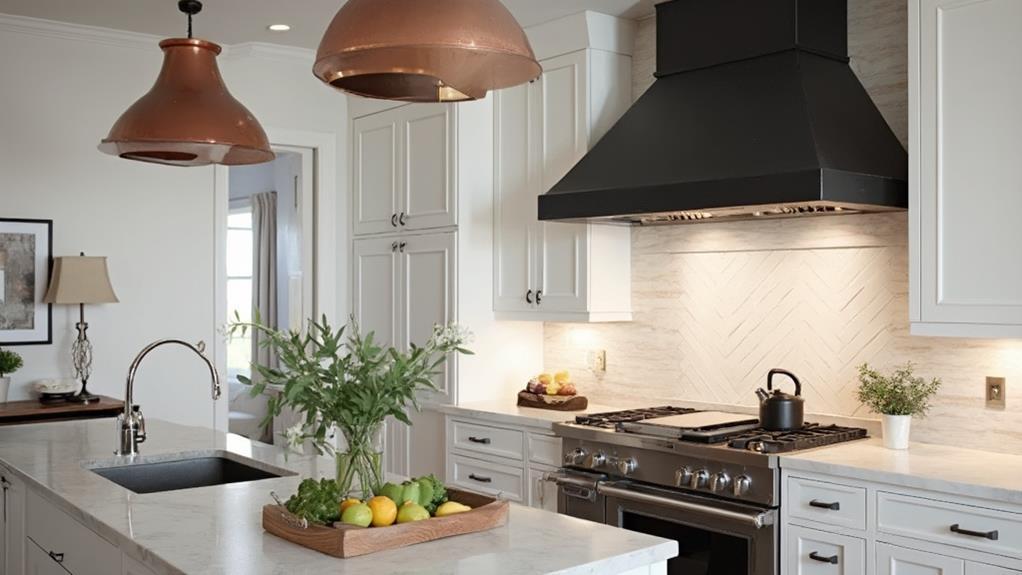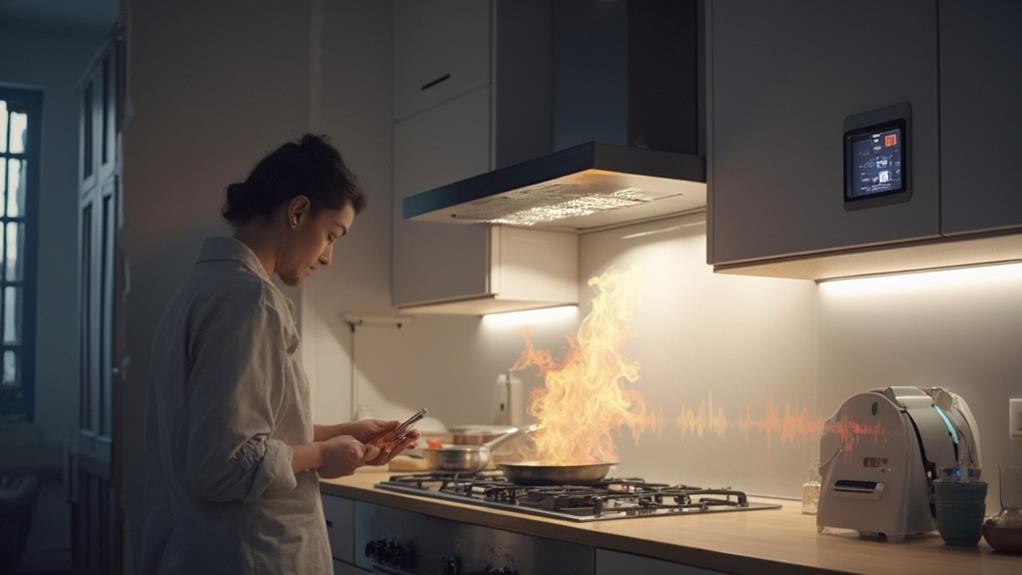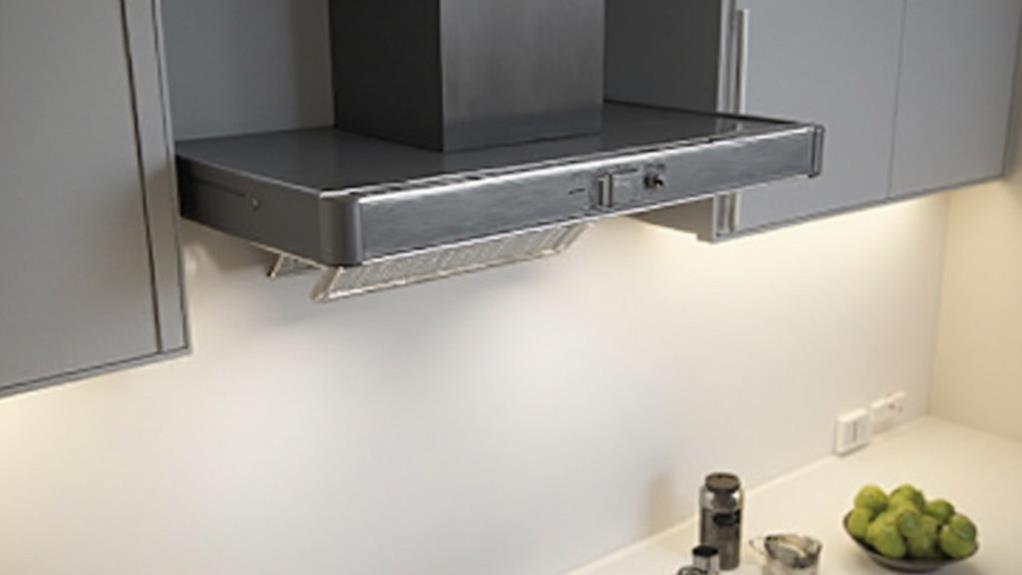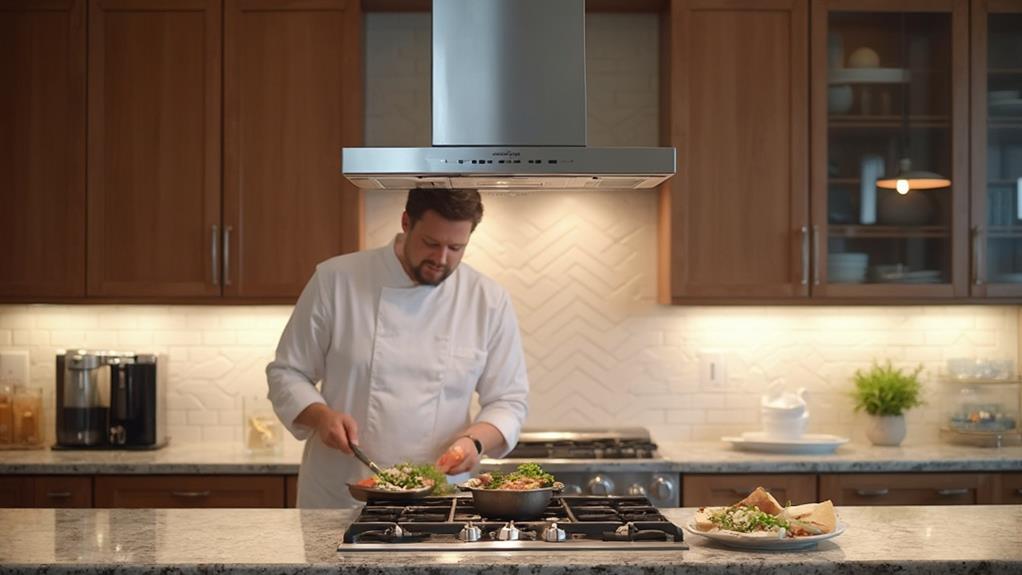To choose the right vent hood, consider your kitchen's layout and cooking habits. Start by selecting a style that complements your space, such as under-cabinet, wall-mounted, or island hoods. Ensure the hood's size matches or slightly exceeds your cooktop's width. Calculate the necessary airflow capacity (CFM) based on your range type and cooking frequency. Don't forget to factor in noise levels and control options for comfort and convenience. Pay attention to installation requirements, including proper ducting and height placement. Finally, select a material that balances aesthetics with maintenance needs. The perfect vent hood awaits as you explore these crucial factors.
Vent Hood Types and Styles

Variety is the spice of life, and it's no different when it comes to vent hoods. You'll find several types and styles to choose from, each with its own advantages and aesthetic appeal. The most common types are under-cabinet, wall-mounted, island, and downdraft vent hoods.
Under-cabinet hoods are perfect for kitchens with cabinets above the cooking area. They're space-efficient and blend seamlessly with your cabinetry. Wall-mounted hoods, also called chimney hoods, are ideal for kitchens without upper cabinets. They make a bold statement and come in various designs, from sleek stainless steel to ornate copper.
Island hoods are suspended from the ceiling and work well for kitchens with a central cooking area. They're often more powerful to compensate for their distance from the cooktop. Downdraft hoods are a unique option that rises from behind your cooktop when needed, perfect for open-concept kitchens or spaces with limited overhead room.
Within these types, you'll find different styles to match your kitchen's decor. Modern, traditional, industrial, and transitional designs are available, ensuring you can find a vent hood that complements your kitchen's aesthetic while providing essential ventilation.
Sizing and Airflow Capacity
When choosing a vent hood, sizing and airflow capacity are crucial factors you can't afford to overlook. The size of your vent hood should match or slightly exceed the width of your cooktop. For optimal performance, aim for a hood that's at least as wide as your cooking surface, if not 3-6 inches wider on each side.
Airflow capacity, measured in cubic feet per minute (CFM), determines how effectively your hood can remove smoke, steam, and odors. As a general rule, you'll need 100 CFM for every 12 inches of stovetop width for electric ranges, and 150 CFM for gas ranges. For example, a 36-inch gas cooktop would require a minimum of 450 CFM.
Consider your cooking habits when selecting airflow capacity. If you frequently cook with high heat or strong-smelling ingredients, opt for a higher CFM rating. Also, factor in your kitchen's size and layout. Larger kitchens or open floor plans may require more powerful vent hoods to effectively clear the air.
Don't forget to check local building codes, as some areas have maximum CFM restrictions or makeup air requirements for high-powered vent hoods.
Noise Levels and Controls

Now that you've considered size and airflow, it's time to focus on noise levels and controls. Vent hood noise is measured in sones, with lower numbers indicating quieter operation. For a peaceful kitchen environment, look for hoods rated at 1-3 sones on low speed and 5-8 sones at high speed.
When selecting controls, consider ease of use and functionality. Most vent hoods offer multiple fan speeds, allowing you to adjust airflow based on cooking intensity. Look for models with intuitive controls, such as push buttons or touch panels. Some high-end hoods feature remote controls or smart home integration for added convenience.
Additional control features to consider include automatic shut-off timers, which turn the fan off after a set period, and heat sensors that automatically adjust fan speed based on cooking temperature. Lighting controls are also important; opt for adjustable brightness settings and the ability to switch between task and ambient lighting.
Don't overlook maintenance indicators, such as filter cleaning reminders, which help you keep your vent hood operating at peak efficiency. By carefully considering noise levels and control options, you'll ensure your vent hood enhances your cooking experience without becoming a nuisance.
Installation and Ducting Considerations
The backbone of an effective vent hood system lies in proper installation and ducting. When planning your vent hood installation, consider the distance between your cooktop and the hood. Most manufacturers recommend a height of 24 to 30 inches for optimal performance. You'll also need to decide between a wall-mounted or island-mounted hood, depending on your kitchen layout.
Ducting is crucial for efficient ventilation. Opt for smooth, rigid metal ducts rather than flexible ones, as they provide better airflow and are easier to clean. Keep duct runs as short and straight as possible, minimizing bends and turns that can reduce efficiency. If you must use elbows, choose gradual 45-degree angles over sharp 90-degree turns.
Ensure your duct size matches your hood's requirements, typically 6 to 10 inches in diameter. Larger ducts can handle higher CFM ratings more effectively. Don't forget to include a wall or roof cap to prevent backdrafts and keep pests out.
If ducting to the outside isn't feasible, consider a ductless (recirculating) hood. While less effective, it's a viable option for apartments or homes where external venting isn't possible. Remember to replace carbon filters regularly in ductless systems to maintain air quality.
Material and Maintenance Requirements

Selecting the right material for your vent hood isn't just about aesthetics; it's crucial for durability and ease of maintenance. Stainless steel is a popular choice due to its resistance to corrosion, heat, and grease. It's easy to clean and maintain, making it ideal for busy kitchens.
Copper vent hoods offer a unique, upscale look but require more maintenance to prevent tarnishing.
For a budget-friendly option, consider powder-coated steel. It's durable and comes in various colors to match your kitchen decor. Glass vent hoods provide a modern, sleek appearance but may show fingerprints and require frequent cleaning.
To maintain your vent hood, clean it regularly with mild soap and water. Avoid abrasive cleaners that can damage the surface. For stainless steel, use a specialized cleaner to prevent streaking. Clean or replace filters monthly, depending on your cooking habits.
Check the manufacturer's instructions for specific maintenance requirements. Some high-end models have self-cleaning features or dishwasher-safe parts, which can simplify upkeep. Remember, proper maintenance not only keeps your vent hood looking great but also ensures its optimal performance and longevity.
Conclusion
As you embark on your vent hood journey, picture the perfect blend of form and function in your kitchen. Envision a sleek, powerful ally whisking away smoke and odors, its quiet hum a testament to thoughtful design. You've weighed the options, measured your space, and considered your cooking style. Now, armed with knowledge, you're ready to select a vent hood that'll seamlessly integrate into your culinary haven, enhancing both its aesthetics and functionality.

